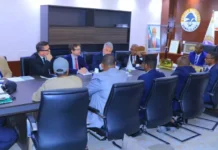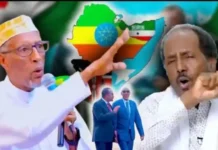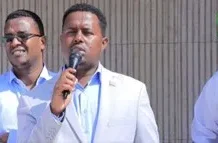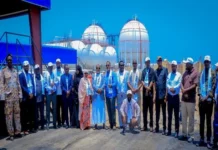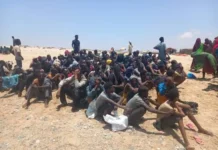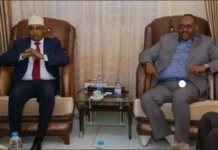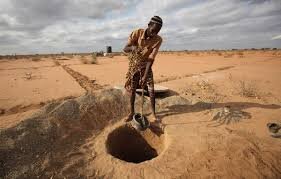Only the most vicious of droughts get a name. The one in Somalia is named Sima.
Bahile Hassan, a 60-year-old grandmother says this is the worst of all of them. Sima, in fact, means “equal” in the Somali language because the drought is hammering everyone equally hard.
Bahile has lived through three droughts with names.
Mahanaw came in the 1980s and this drought mostly aected rural villages. In the 1990s, the communities faced another drought named Mahadiid which was made worse by the civil war. These two droughts mostly aected livestock, the main lifeline for Somali communities. Today, Somalis are living through yet another: Sima. It is apparently the worst of the three.
My name is Anisa Hussein and I work for the ICRC’s Somalia delegation. I recently travelled to the Galgaduud region of Somalia, which lies 450 kilometres north of Mogadishu. It is known for its large jacaranda trees, red soil, and uncomfortably rocky roads. But what I found there was an overwhelming sense of anguish.
When we arrived in the village of Gidheys, a crowd gathered, hoping for help. I looked at the faces in the crowd, hoping to find a man named Abdulahi Abdrahman – a pastoralist I met two years ago in the same area. Abdulahi spoke about the livestock he lost due to the harsh conditions of the drought. I don’t see him in the crowd – he is probably in another part of Somalia, searching for rain.
I heard the word “Abaar” repeated in most of the conversations. “Abaar” means drought in Somali. Among the crowd is Sowdhe Ali, a 63-year-old father of 11 children. He begins to tell me about the livestock he lost. His words are slow and heavy with emotion.
“I had 400 goats and five camels in 2016. The drought “ate” 100 of my goats and three camels. Then came 2017: out of the 300 goats remaining, the drought again claimed 150 goats and the remaining two camels. I started 2018 with a total of 150 goats which were decimated, leaving me with only 40. This year I have a small herd of 50 – weak, but alive.”
I have been travelling to Somalia for two years with the International Committee of the Red Cross (ICRC). I have seen how devastating the mix of drought and conflict can be on communities. This is not just Sowdhe’s story. It is the story of Somalia.
Sima is said to have started in 2011, triggering a famine that claimed the lives of a quarter of a million people. While the world has largely moved on, for people like Bahile and Sowdhe, the drought has never ended, but ebbed and flowed in severity.
Between the years 2016 and 2017 Somalia faced one of its most severe droughts due to consecutive poor rainy seasons which pushed the country to the brink of famine with over half of the population in desperate need of assistance. The drought triggered crop failure and high levels of livestock deaths and sickness. Towns and villages were painted with dots of animal carcasses from one corner to the other.
Fast forward to 2019, the rains came late and when they did come, they were not enough. Crops failed. It was harder to keep livestock alive. Communities once again were plunged into crisis and today, food is a constant struggle for many.
For some, aid is the only means of survival that they know.
Sowdhe told me he has witnessed a change in drought patterns over the years. Pastoralists normally rely on two rainy seasons observed each year in Somalia: the Gu – or long rains between April and June – and the Deyr, or short rains between October and December. However, he cannot remember the last time these seasons were consistent, and if anything, the rains have been low or failed to fall at all. He told me that while there has been some rainfall in recent weeks, but it has been below what was expected and needed, leading to a shortage of water and food.
“I am in debt of $2,000 that I am still struggling to pay,” he said. “There is no grass or pasture, the livestock have become like humans – we feed them the little we eat which are these seeds we pluck from the trees outside our huts.”
We haven’t had time to recover and the rains have been continuing to decrease every single season
Our teams cannot make the rains come, but they are doing what they can: Sowdhe, Bahile, and more than 9,200 families in Galgaduud are receiving cash that we hope will help them meet their most pressing needs. We are doing this across 11 regions, reaching some 186,000 people with cash and will then follow up with seeds and planting tools and other initiatives to help people recover.
I can’t help but think about the future of these communities. Can Sowdhe’s remaining livestock and those of other pastoralists survive another drought? Will the seasonal rains ever return? Or are climate shocks the new norm for Somalia?
For Bahile, the never-ending drought has left people with no option but to leave altogether.
“Our youth, children and the elderly have left for other towns, some come back but others don’t even look back,” she said. “In a total of four years (2016 – 2019), it has rained 3 times, once each year which is very little.”
She pauses for a moment. I imagine that she may be recalling a time when the rains were not as scarce as they are today. She then appears to return to the present and continues.
“We haven’t had time to recover and the rains have been continuing to decrease every single season,” she says.
ICRC


